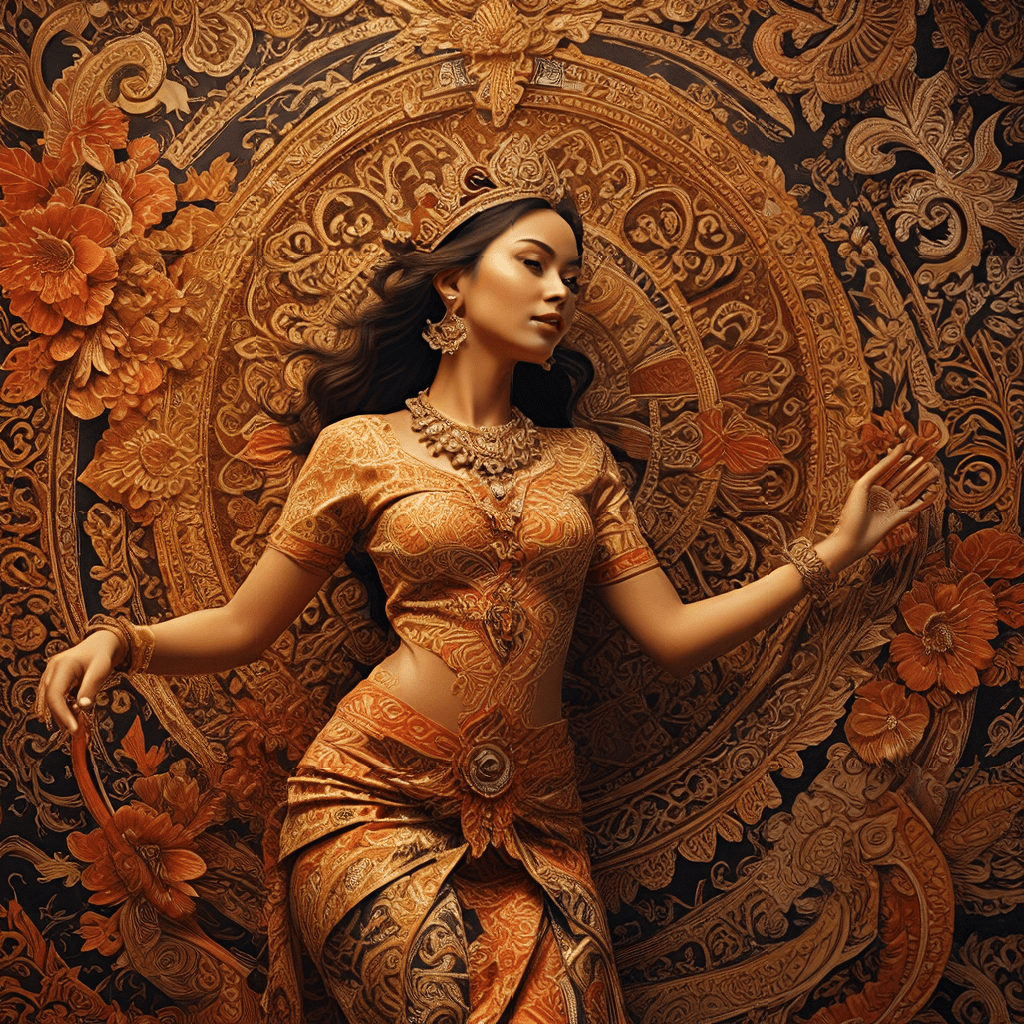Indonesian Mythology and the Power of Batik
Indonesia, an archipelago of over 17,000 islands, is renowned for its vibrant culture, rich history, and intricate art forms. Among these, batik, a traditional wax-resist dyeing technique, holds a special place. More than just a craft, batik in Indonesia is deeply entwined with mythology, beliefs, and social structures. It serves as a visual language, a medium for storytelling, and a connection to the divine and ancestral realms.
The intricate patterns and vibrant colors of batik are not merely decorative; they hold symbolic meanings that have been passed down through generations. Each motif, from flowers to animals to geometric designs, carries a specific message, reflecting Indonesian beliefs, values, and aspirations. Batik is more than just cloth; it's a visual tapestry of myths, legends, and cultural wisdom.
The Divine Origin of Batik: Myths and Legends
The origins of batik are shrouded in myths and legends that speak to its sacred origins. One popular tale tells the story of the goddess Ni-Ijo, who descended from heaven to teach the art of batik to the people of Java. This myth highlights the divine connection attributed to batik, elevating it from a mere craft to a sacred practice.
Another legend speaks of a king who was gifted a magical cloth that could be dyed with vibrant colors, each color representing a different virtue. The king's wife, inspired by this gift, learned to create similar patterns on cloth using wax and dyes, thus giving birth to the art of batik. These stories, while fictional, underscore the deeply rooted belief in the power and significance of batik.
The Language of Patterns: Deciphering Batik Symbolism
Indonesian batik patterns are a language, rich with symbolism that communicates stories, beliefs, and social status. Each motif, from the humble flower to the majestic dragon, carries a specific meaning.
For example, the "bunga tanjung" (frangipani flower) represents purity and beauty, often used in wedding attire. "Kawung," a geometric pattern of four circles, symbolizes unity and balance, reminding the wearer of the interconnectedness of life. The "pisang" (banana) design signifies fertility and abundance, while the "merak" (peacock) symbolizes beauty, elegance, and royalty.
Understanding these symbols allows us to appreciate the depth and complexity of Indonesian culture, encapsulated within the seemingly simple patterns of batik.
The Symbolic Power of Colors in Batik Art
Colors play a crucial role in batik, each hue carrying its own symbolic weight. Red, symbolizing courage, passion, and life, is often used in ceremonial garments. Blue, representing calmness, wisdom, and the divine, is associated with spiritual rituals. Green, symbolizing growth, prosperity, and the earth, is linked to the agricultural practices of the Indonesian people. Yellow, representing nobility and royalty, is often found in the attire of the upper classes.
The combination of colors in a batik design creates a visual tapestry of meanings, adding another layer of complexity to its symbolism. The skillful application of colors, paired with the intricate patterns, allows batik to convey a wide range of emotions, beliefs, and cultural nuances.
The Role of Batik in Rituals and Ceremonies
Batik plays a significant role in various Indonesian rituals and ceremonies, from weddings and births to funerals and village festivals. For example, "kain batik" (batik cloth) is an essential part of wedding attire, with the patterns and colors chosen to symbolize blessings for the newlyweds.
During funerals, specific batik patterns are worn to honor the deceased and their legacy. The use of batik in these rituals underscores its profound connection to the spiritual and social fabric of Indonesian life. It's not merely about dressing up; it's about engaging with tradition, beliefs, and the spiritual realm through the art of batik.
The Cosmic Significance of Batik Patterns
Batik patterns often reflect the Indonesian belief in the interconnectedness of all things, mirroring the cosmic order and the natural world. The "mega mendung" (cloud pattern), for example, symbolizes the cyclical nature of life, representing the constant movement of clouds across the sky. This motif reminds people of the ephemeral nature of life and the importance of embracing change.
The "ceplok" (circle pattern), frequently used in batik designs, evokes the sun, moon, and stars, representing the celestial bodies that govern the universe. This pattern reinforces the belief in the power of the cosmos and the importance of aligning oneself with its rhythms. Beyond simply representing celestial bodies, the "ceplok" can also symbolize wholeness, unity, and the interconnectedness of all beings.
These patterns serve as visual reminders of the larger cosmic order, connecting the wearer to the universe and its vast forces. Batik, in this way, becomes a conduit for understanding and engaging with the spiritual realm.
Batik as a Reflection of Social Hierarchy and Identity
Batik is not just art; it's a powerful symbol of social status and identity within Indonesian society. The complexity and intricacy of the patterns, the quality of the fabric, and the use of colors can signify wealth, lineage, and social standing.
For example, royal families and noble houses often wear batik with intricate designs and rich colors, signifying their high status. The "parang" (wave pattern), with its sharp and bold lines, is associated with warriors and leaders, symbolizing strength and power. These patterns were often reserved for the elite, serving as visual markers of their social position.
However, batik traditions vary across different regions and communities, each with its own unique styles and symbolism. These variations reflect the diverse cultural identities and histories of the Indonesian archipelago. Therefore, while batik can represent social hierarchy, it also reveals the richness and complexity of regional cultures within Indonesia.
Batik and the Ancestral Spirits: Connecting to the Past
Batik is deeply entwined with the belief in ancestral spirits, the "nenek moyang," who are seen as guardians and protectors of the community. In many rituals, specific batik patterns are worn to honor and appease these spirits. For example, the "sekar jagad" (flower of the universe) pattern is often used in ceremonies to connect with the ancestors, symbolizing their wisdom and guidance.
By wearing batik with these patterns, individuals tap into the wisdom and knowledge of their ancestors, seeking their blessings and protection. This tradition highlights the importance of honoring the past and maintaining a connection with the ancestral lineage.
Batik, therefore, acts as a bridge between the living and the dead, allowing individuals to access the spiritual wisdom and guidance of their forefathers. This connection to the past imbues batik with a sense of history, tradition, and continuity.
The Enduring Legacy of Batik Symbolism in Indonesian Culture
The symbolism of batik remains deeply embedded in Indonesian culture, even today. Batik patterns are woven into everyday life, appearing in clothing, furniture, textiles, and even architecture. This enduring legacy highlights the enduring power and significance of this art form.
Modern-day Indonesians continue to wear batik for special occasions, reflecting their cultural pride and connection to their heritage. The motifs and colors chosen often reflect personal values, aspirations, and even social activism. Batik, therefore, remains a powerful tool for expressing identity, beliefs, and cultural values.
Contemporary Interpretations of Batik Symbolism: Reimagining the Past
While batik traditions remain strong, contemporary artists are exploring new interpretations of its symbolism, reimagining the past for a modern audience. New designs and patterns are emerging, drawing inspiration from the traditional motifs but adapting them to contemporary themes. This creative process reflects the adaptability and dynamism of batik, ensuring its relevance and vitality within modern Indonesian society.
Modern artists might fuse traditional batik motifs with themes of sustainability, social justice, or technological innovation. This innovative use of traditional symbolism keeps batik relevant and engaging for a younger generation, proving the art form’s capacity to adapt to changing times while staying true to its core values.
FAQ (Frequently Asked Questions)
Q: What is the significance of batik patterns in Indonesian mythology?
A: Batik patterns are deeply intertwined with Indonesian mythology, representing beliefs, values, and cosmic order. Each pattern, from flowers to animals, holds a symbolic meaning, reflecting the interconnectedness of life, the power of the universe, and the importance of ancestral spirits.
Q: How does batik reflect social hierarchy in Indonesia?
A: The complexity and intricacy of batik patterns, the quality of the fabric, and the use of colors can signify wealth, lineage, and social standing. Certain patterns, like "parang," are associated with warriors and leaders, symbolizing strength and power, while other patterns may be reserved for the elite.
Q: What is the role of batik in rituals and ceremonies?
**A: ** Batik is an essential part of various Indonesian rituals and ceremonies, from weddings and births to funerals and village festivals. Specific patterns and colors are chosen to symbolize blessings, honor ancestors, and appease spirits, demonstrating the deep connection between batik and the spiritual realm.
Q: How is batik adapting to contemporary culture?
A: While batik traditions remain strong, contemporary artists are exploring new interpretations of its symbolism, reimagining the past for a modern audience. New designs and patterns are emerging, drawing inspiration from traditional motifs but adapting them to contemporary themes, keeping batik relevant and engaging for a younger generation.



